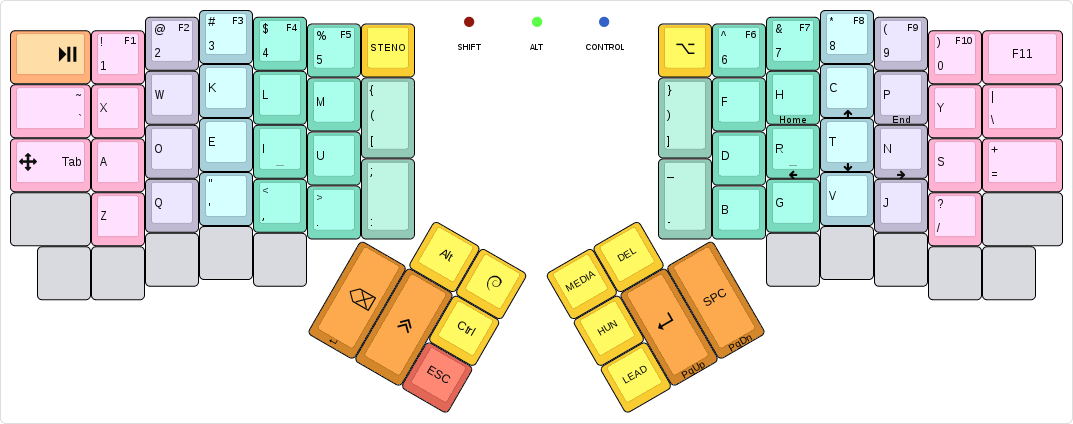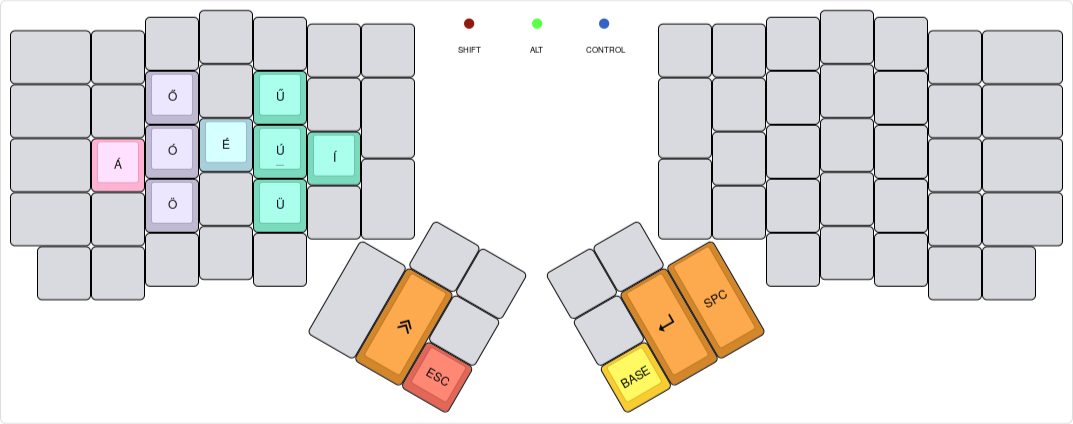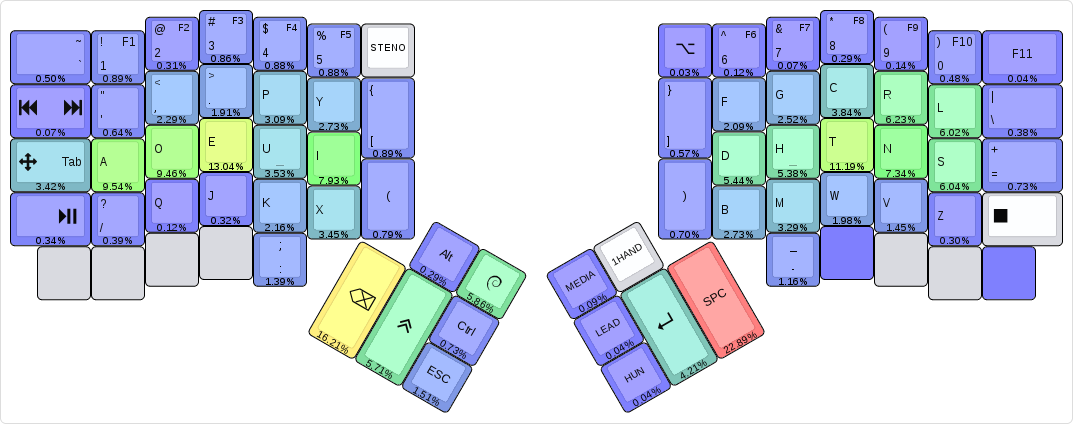This reworks how the tap-dance feature works: instead of one global state, we have a state for each tap-dance key, so we can cancel them when another tap-dance key is in flight. This fixes #527. Since we have a state for each key, we can avoid situation where a keyup would mess with our global state. This fixes #563. And while here, we also make sure to fire events only once, and this fixes #574. There is one breaking change, though: tap-dance debugging support was removed, because dumping the whole state would increase the firmware size too much. Any keymap that made use of this, will have to be updated (but there's no such keymap in the repo). Also, there's a nice trick used in this rework: we need to iterate through tap_dance_actions in a few places, to check for timeouts, and so on. For this, we'd need to know the size of the array. We can't discover that at compile-time, because tap-dance gets compiled separately. We'd like to avoid having to terminate the list with a sentinel value, because that would require updates to all keymaps that use the feature. So, we keep track of the highest tap-dance code seen so far, and iterate until that index. Signed-off-by: Gergely Nagy <algernon@madhouse-project.org> |
||
|---|---|---|
| .. | ||
| images | ||
| tools | ||
| config.h | ||
| COPYING | ||
| keymap.c | ||
| Makefile | ||
| readme.md | ||
algernon's layout
This is an unconventional layout for the ErgoDox EZ. For more details about the history of the layout, see my blog posts about my ErgoDox journey.
Some of the things in the layout only work when one uses Spacemacs and GNOME under Linux. Your mileage may vary.
Table of Contents
Layouts
Base layer
At its core, this is a Dvorak layout, with some minor changes. The more interesting parts are how certain keys behave:
- The keys on the number row double as function keys, when held for a bit longer than an usual tap. This allows me to use the function keys without having to switch layers.
- The
Shift,Alt, andControlmodifiers are one-shot. When tapped, they are considered active for the next key press only. When double tapped, they toggle on, until a third, single tap sometime later. When held, they act as expected. My usual pattern is that I use these for the next keypress only, so this behaviour is perfect. If I need them held, I'll just double-tap. - The
GUIkey is special, because when I double-tap it, it sendsGUI + w, which pops up an application selector. It also switches to a one-shot layer, where the number row on the left half turns into app selector macros, for the most common things I usually want to switch to. Otherwise it behaves as on a normal layout. - The
ESCkey also doubles as a one-shot cancel key: if tapped while any of the one-shot modifiers are in-flight (as in, single-tapped, and not expired yet), it cancels all one-shot modifiers. It also cancels the Hun layer, if active. Otherwise it sends the usual keycode. - The Media and Hun layer keys are one-shot, the STENO key is a toggle.
- When holding any of the Arrow layer keys, the arrow layer activates while the layer key is held. Tapping the key produces the normal key.
- Tapping the
:key once yields:, tapping it twice yields;. - The Lead key allows me to type in a sequence of keys, and trigger some actions:
LEAD uenters unicode input mode, by sending the GTK+ key sequence that does this.LEAD luses the unicode input method to enter aλ.LEAD sdoes a lot of magic to type in a shruggie:¯\_(ツ)_/¯LEAD ytypes\o/.LEAD w mmaximises the currently focused window.LEAD amakes the ADORE layer the default.LEAD vprints the firmware version, the keyboard and the keymap.LEAD dtoggles logging keypress positions to the HID console.LEAD ttoggles time travel. Figuring out the currentdateis left as an exercise to the reader.LEAD LEAD uenters the [Unicode symbol input][#unicode-symbol-input] mode.
ADORE layer
While using the standard Dvorak layout, I encountered a number of inconveniences, and on this layer, I am playing with ideas to make the layout feel better. Initially, it was based on Capewell-Dvorak, but that too, had shortcomings I was not happy with. So now this is something inbetween, with own observations thrown in. How it works out in the long run remains to be seen.
Based on a week and a half of typing, the keys were rearranged, and the home row neatly spelled out ADORE, that gave the layout its name.
Hungarian layer
On this layer, the accented characters are at the same position as their base variant. For some, which can have other diatribes, the long one is on top, short's on bottom. Tapping any of the accented characters takes us back to the base layer.
Navigation and media layer
This layer is primarily for navigating with the cursor or the mouse, and some media things.
Steno layer
This is to be used with Plover, nothing really fancy here. The STENO key toggles the layer on and off, and sends the toggle command to Plover too.
LED states
The primary purpose of the LEDs is to show the modifier status, a secondary, to show which layer is active. Each modifier, Shift, Alt and Control each have their designated LEDs: the red, green and blue, respectively. When a modifier is in a one-shot state, the respective LED will turn on with a dimmer light. If the modifier is toggled on, the brightness of the LED turns full.
For the layers, the following rules apply:
- When the ADORE layer is toggled on, LEDs will light up from left to right in a sequence, then turn off. When the layer is toggled off, the LEDs light up and turn off in the other direction. No LEDs are on while the layer is active.
- When the Hungarian layer is active, the green and blue LEDs are on.
- When the Navigation and media layer is active, the red and green ones are on.
- For the Steno layer, all LEDs will be turned on.
Unless noted otherwise, the layers use a dim light for the LEDs, while modifiers use a stronger one, and modifiers override any layer preferences. For example, when on the one-handed layer, with the left side active (red light blinking), if Shift is on, the red light will be constantly on.
Special features
Unicode Symbol Input
Once in the Unicode Symbol Input mode, one is able to type in symbol names, press Enter or Space, and get the Unicode symbol itself back. When in the mode, a capital U is printed first. Once the sequence is finished, all of it is erased by sending enough Backspace taps, and the firmware starts the OS-specific unicode input sequence. Then, it looks up the symbol name, and enters the associated code. If it is not found, it will just replay the pressed keycodes.
The currently supported symbols are:
snowman: ☃kiss: 😙rofl: 🤣poop: 💩
This is an experimental feature, and may or may not work reliably.
Tools
Heatmap
When the keypress logging functionality is enabled (by LEAD d), the keyboard will output a line every time a key is pressed, containing the position of the key in the matrix. This allows one to collect this information, and build analytics over it, such as a heat map, including dead keys too.
Included with the firmware is a small tool that can parse these logs, and create a heatmap that one can import into KLE. To use it, simply point tools/log-to-heatmap.py to a base layout file (one is included in the tools/ directory), and the key position log. The latter one can create by running hid-listen, and redirecting its output to a file.
The generated heatmap looks somewhat like this:
Building
To make my workflow easier, this layout is maintained in its own repository. To build it, you will need the QMK firmware checked out, and this repo either checked out to something like keyboards/ergodox_ez/algernon-master. One way to achieve that is this:
$ git clone https://github.com/jackhumbert/qmk_firmware.git
$ cd qmk_firmware
$ git clone https://github.com/algernon/ergodox-layout.git \
keyboards/ergodox/keymaps/algernon-master
$ make keyboard=ergodox keymap=algernon-master
From time to time, updates may be submitted back to the QMK repository. If you are reading it there, you can build the firmware like any other firmware included with it (assuming you are in the root directory of the firmware):
$ make keyboard=ergodox keymap=algernon
Using on Windows
The keymap default to forcing NKRO, which seems to upset Windows, and except the modifiers, none of them work. If you experience this problem, recompile the firmware with FORCE_NKRO=no added to the make command line.
Changelog
v1.5 - 2016-08-12
- The 1HAND layer has been removed.
- A
Deletekey is now available on the right thumb cluster. - The ADORE layer received a major update, see the layout image above.
- It is now possible to enable automatic logging for the ADORE layer, by setting the
ADORE_AUTOLOGmakefile variable toyeswhen compiling the keymap. It is off by default. - The
~key and theMedia Next/Prevkey have been swapped on the base layer. - On the ARROW layer,
Backspacehas been replaced byEnter. - There is some experimental support for entering Unicode symbols.
v1.4 - 2016-07-29
- When toggling the key logging on or off, the LEDs will do a little dance.
- The keylogger is now optional, but enabled by default. Use
KEYLOGGER_ENABLE=noon themakecommand line to disable it. - The
TAB/ARRWkey was turned into a tap-dance key, allowing one to toggle the ARROW layer on by double-tapping, and as such, avoid the need to hold the key. - The
-/_key was turned into a tap-dance key too. - There is now a way to travel time with the keyboard, toggle the feature on by hitting
LEAD t.
v1.3 - 2016-07-06
- Added support for logging keys, by pressing
LEAD d. Also included is a tool to generate a heatmap out of the logs. - The arrow and navigation keys were rearranged again, and now require an additional key being held to activate. See the base layer for an image that shows where arrows are.
- The experimental layer has been redone, and is now called ADORE, and as such, can be enabled by
LEAD anow. - Switching between Dvorak and ADORE is now persisted into EEPROM, and survives a reboot.
v1.2 - 2016-06-22
- The forced NKRO mode can be easily toggled off at compile-time, to make the firmware compatible with certain operating systems.
- The
:;key has changed behaviour: to access the;symbol, the key needs to be double-tapped, instead of shifted. - The
=and\keys were swapped,=moved to the home row, on both the base and the experimental layers. - The arrow and navigation keys were redone, they are now more accessible, but the navigation keys require an extra tap to access.
- The Emacs layer is gone, replaced by a simplified navigation and media layer.
LEAD vtypes the firmware version, and the keymap version.- On the experimental layer, the
LandQ, and theKandGkeys were swapped. - The Steno layer gained a few more
#and*keys, to make it easier on my fingers.
v1.1 - 2016-06-14
- The keyboard starts in NKRO mode, bootmagic and other things are disabled.
- A Steno layer was added, to be used with Plover.
- An experimental layer was added, something halfway between Dvorak and Capewell-Dvorak. A work in progress.
LEAD ytypes\o/.- Some keys on the Base layer have been moved around:
?moved to the left pinky, left ofQ.=shifted one row down, butF11stayed where it was.-on the left half was replaced byTab.Tab's original position is taken by aMedia Next/Media Prevkey.:now inputs;when shifted.
ESCcancels the Hungarian layer too, not just modifiers.
v1.0 - 2016-05-26
Initial version.
License
The layout, being a derivative of the original TMK firmware which is under the GPL-2+, this layout is under the GPL as well, but GPL-3+, rather than the older version.





